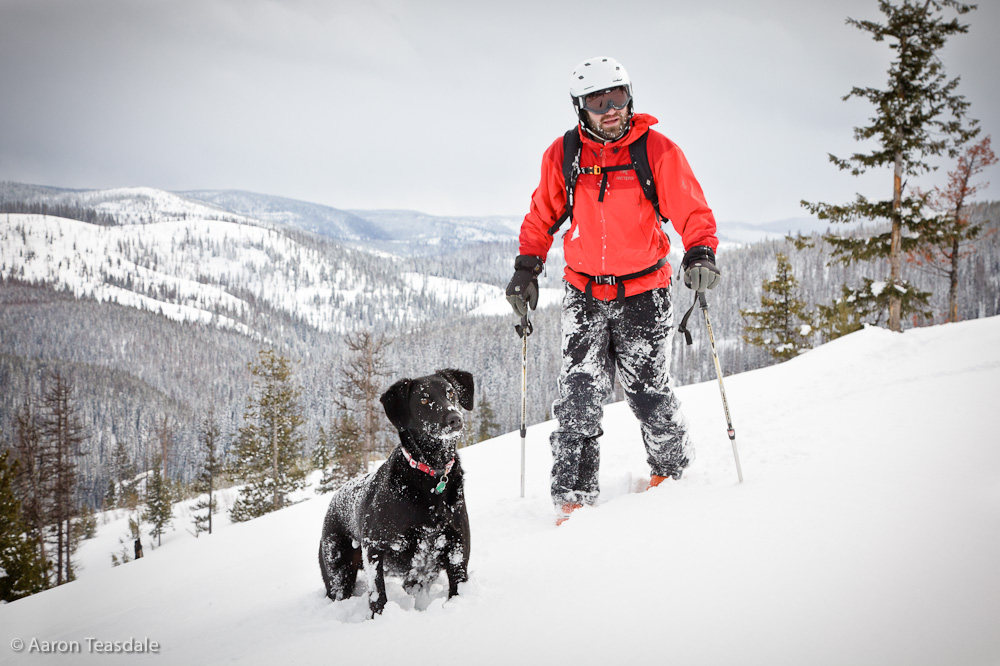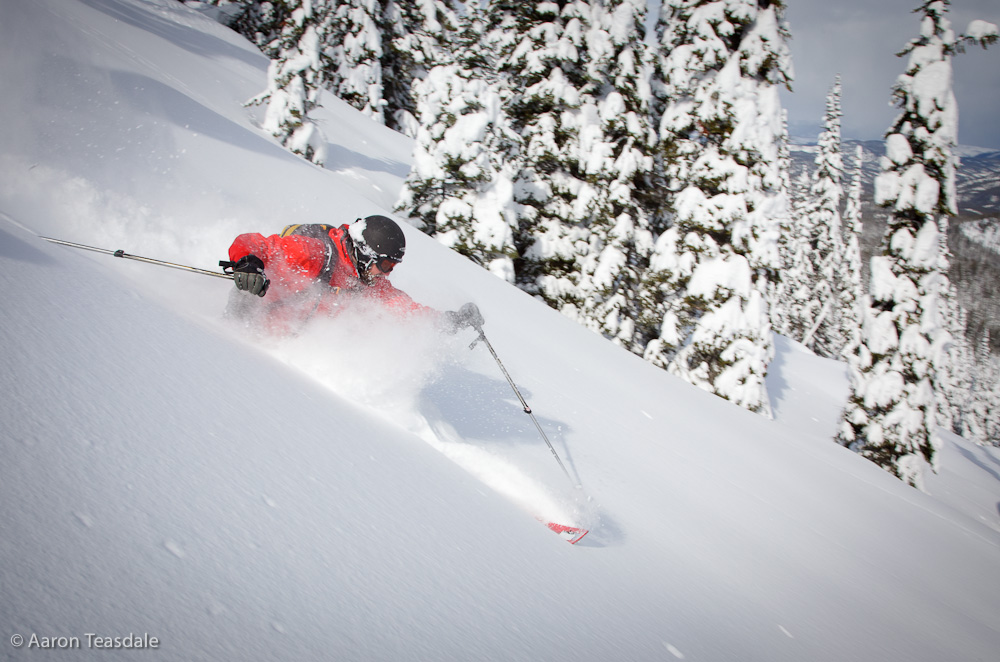There are few things I enjoy more than a long, leisurely hike, the freedom of flip flops and shorts, and the near silent glide of my canoe across the water. Summer days are easy, and here in Western Montana, seemingly endless. Evening light lingers in the sky until past 10 o’clock, and the sun has already dried the dew when my alarm sounds the start of a new day. Yes, summer days are simple and relaxing.
But although summer days seem to last forever, summer itself doesn’t stick around very long. Fall comes quickly to this corner of the world and after a couple of short months of crisp days and bright sunshine, winter follows. Flip-flops are replaced by heavy boots, shorts by flannel-lined jeans, a down parka becomes the costume of choice for those willing to abandon their sense of fashion for the cozy function of insulation. And though I miss the ease and abandon of a long summer afternoon, I don’t mourn its passage. I celebrate. Because with winter comes snow and with snow comes skiing.
As my colleagues, my friends, my long-suffering wife, and my spurned family will no doubt attest, I’m something of a skiing junkie. And winter gives me a four month long fix. I grew up in the East and was fortunate to spend countless weekends at local resorts, blasting down groomed ski runs as fast as I dared. I loved it, but it wasn’t until I moved to Alaska after college that I truly got hooked. Too broke to ski at the local resort, I found some friends who could teach me the basics of backcountry skiing. I pieced together gear – used bindings, used skis, discounted boots, an avalanche beacon, probe, and collapsible shovel, and began to earn my turns.
The magic of traveling through the mountains in winter driven only by the power of your legs and lungs is ample reward for any discomfort, perceived or real.
Backcountry skiing isn’t the easiest thing to do, I’ll happily admit that. There’s no lodge with hot chocolate and comfortable seats waiting at the base. Conditions are variable. No groomer erases yesterday’s tracks. No chair whisks you up to the summit. Wind and blowing snow obscure routes and paint packs and jackets white. You can get hot and sweaty hiking up and cold and wet skiing down. You need the proper gear. You need competent partners. But the magic of traveling through the mountains in winter driven only by the power of your legs and lungs is ample reward for any discomfort, perceived or real.
I’m not some strung out adrenaline junkie, always on the hunt for the next peak to shred or the steepest couloir to hike. Of course, it’s thrilling to reach the top of a peak and know that the only tracks below are the ones that you set getting to the summit. But more than that, it’s the silence, the solitude, the escape from mechanism and machinery that bring me back to the trailhead, that roust me from a warm bed on a Saturday morning to slide into a cold truck and drive slippery mountain roads. There is no waiting in line. No feeling like you missed the best part of the day because your friend was late, or you took a wrong turn on your way to the resort.

Backcountry skiing isn’t easy. But it is simple. This may
sound counter-intuitive. How could something that requires a fairly high level
of skill, some important (and expensive) pieces of gear, and a commitment to
hike thousands of vertical feet only to slide back down be simple? Well,
because that’s all you need: a few pieces of specialty gear, a decent pack,
some basic knowledge, and a willingness to hike. Special bindings allow you to
release your heel and pivot your boot on the ski. Heel risers make climbing easier.
A day pack nestled snuggly on your back contains all the extra clothes, food,
emergency supplies, water, and maps you need. Climbing skins affixed to the bottom
of your skis allow you to climb up steep pitches without sliding backwards. At
the top, they are removed and stowed in your pack.
Like many things that are hard to define, backcountry skiing might be best defined by what it isn’t. It’s not about getting as many runs as possible. It’s not about showing off the latest gear or skiing the fastest down a run. It’s not about how many black diamonds you skied, or how many times you didn’t fall. It’s not about fancy lodges and fur-lined boots. It’s about giving up control and letting the mountains dictate your route, if you make it to the top, or if you turn around part way up. Though it may be over-used and borderline trite, backcountry skiing truly is about the journey, not the destination.
The forests are quiet and softened by the snow. Muted voices barely reach their intended recipient. If I’m out alone, which I often am, I choose my route based solely on my momentary whims.
Please don’t think I’m a resort hating hippie, or a miserly misanthrope, too cheap to plunk down my hard-earned cash for a dozen easy rides to the top. I love skiing at resorts. I spent years at several, teaching skiing, working as a waiter, a janitor, an office administrator, doing whatever it took to get a ski pass and ride the lift every day. And I still spend a few days at the resort each season. But, over time, I found myself riding the lift to access terrain just outside of the ski boundary. I never ducked ropes or broke rules (ok, almost never), but I made full use of backcountry gates and of what skiers call “side-country” terrain. Eventually, I realized that I didn’t really need the lifts at all.
Over the years, I’ve come to enjoy traveling on skis through the snow so much that I don’t even need the lure of a big peak and its attendant downhill schuss. Close to half of my ski outings now consist of exploring Forest Service roads and following animal tracks through the woods. I still very much consider this backcountry skiing. There are no groomed routes, no signs warning of steep descents or that the old road I’m on might simply end around the next bend. There are no lodges, no roaring fires behind comfortable couches waiting for me at the bottom of the hill, just a cold truck and some semi-frozen Gatorade. The forests are quiet and softened by the snow. Muted voices barely reach their intended recipient. If I’m out alone, which I often am, I choose my route based solely on my momentary whims. Follow those elk tracks – yes I think I will. Switchback up that shoulder – sure what the heck, I’ve always wondered what’s on the other side of that ridge. Turn around and head home? Not quite yet, but soon.

Backcountry skiing is freeing in a way few other pursuits
can match. No dense undergrowth prevents your passage through the woods. No
trails or signs compel you one way or another. No engineer or chainsaw-wielding
resort employee dictates your route up or down the mountain. All the supplies
you need are on your back, ready for you to use. The lifts don’t close at 4:00.
There’s no compulsion to get as many runs as possible because you just spent 75
bucks on a ticket. No first chair to get in line for, no “no friends on a
powder day” philosophy. There is simply you, your friends (or loyal dog), fresh
snow, and the knowledge that once you get to the top, gravity will get you back
down again.

